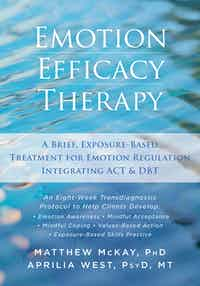Part one of a four-part series on emotion efficacy therapy
By Matthew McKay, PhD, and Aprilia West, PsyD
Mindful acceptance in emotion efficacy therapy (EET) is a way of responding to emotional activation without reacting, judging, or controlling the experience. It can be a radically different and transformative practice for clients who have never understood how to surf their emotion waves instead of being swept up into their emotions. The goal of mindful acceptance is to learn to tolerate distressing emotions, and often clients find that by allowing the experience, their distress also decreases.
Mindful acceptance can be taught to clients first through introducing them to emotion awareness, that is—learning to identify the way emotions show up through thoughts, sensations, feelings, and urges. Once your client is able to identify these four components of an emotion, they can practice mindful acceptance with each one:
-
Accepting sensations
-
Watching thoughts
-
Labeling feelings
-
Noticing urges
To help clients learn how to practice, you’ll want to first have them practice in a non-activated state before moving into emotion surfing in an activated state.
You can use the following script to lead your client or group of clients through a guided mindful acceptance practice. Note: if you are using the script in individual therapy, you’ll leave space in the script for the client to describe each of the components as you lead them through.
For the next ten minutes, you will practice nonjudgmentally observing and accepting your emotional experience in the present moment. This is called mindful acceptance. Practicing mindful acceptance in a non-triggered state will build your emotional efficacy muscle, and make it easier for you to use this skill when you are triggered.
First, sit comfortably and either close your eyes, or focus on a spot in front of you.
Now, we’ll spend a few minutes noticing any sensations in your body. Scan your body until you find a sensation and just rest your attention on it. See if you can let it be just as it is; get curious about it. Notice its size and shape; whether its moving or staying the same; if there’s any temperature or tension to it. Now see if you can soften to it, or even lean into the sensation.
Next, see if you can identify a feeling label that goes with the sensation.
Now we’ll spend a few minutes just noticing and watching our thoughts. We all have different kinds of thoughts, so when you notice one, you can simply say, “there’s a thought” or “just thinking,” and then let the thought go. Then just return to the present moment, and wait for the next thought to arise. The key is to just notice it, but don’t get involved in it. Once you let it go, just return to the present moment, and wait for the next thought to arise. For the next few minutes, notice your thoughts until I say stop. (two minutes)
Finally, see if there’s an urge that goes with your sensations or thoughts. It could be an urge to do something, or not to do something. Notice what it’s like not to act on the urge, but to just surf it.
 Matthew McKay, PhD, is a professor at the Wright Institute in Berkeley, CA. He has authored and coauthored numerous books, including The Relaxation and Stress Reduction Workbook, Self-Esteem, Thoughts and Feelings, When Anger Hurts, and ACT on Life Not on Anger.
Matthew McKay, PhD, is a professor at the Wright Institute in Berkeley, CA. He has authored and coauthored numerous books, including The Relaxation and Stress Reduction Workbook, Self-Esteem, Thoughts and Feelings, When Anger Hurts, and ACT on Life Not on Anger.
Aprilia West, PsyD, MT, is a psychotherapist and emotion researcher based in the San Francisco Bay Area, where she specializes in treating anxiety disorders, mood disorders, and trauma.

 2024 Peace Playbook: 3 Tactics to Avoid Clashes with Your Partner
2024 Peace Playbook: 3 Tactics to Avoid Clashes with Your Partner